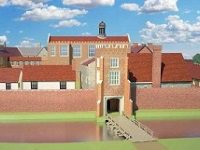The moated medieval manor and Tudor royal residence at Woking Palace. Excavations between 2009 and 2015
By Rob Poulton
 Community excavations from 2009 to 2015 have revealed the development of Woking Palace. King Richard I granted the manor to Alan Basset and soon after he created a moated residence. By around 1300 the complex included stone buildings that thereafter always formed the core of the privy lodgings, a great hall, household and privy kitchens, and lodgings for courtiers.
Community excavations from 2009 to 2015 have revealed the development of Woking Palace. King Richard I granted the manor to Alan Basset and soon after he created a moated residence. By around 1300 the complex included stone buildings that thereafter always formed the core of the privy lodgings, a great hall, household and privy kitchens, and lodgings for courtiers.
The aristocratic lifestyle is shown by stonework in Sussex marble, patterned floor tiles, grisaille window glass, and the consumption of swan and deer. In particular fallow deer must have come from the nearby hunting park, established in tandem with the manorial site.
Woking was always held by great families with close connections to the crown. In 1485 Lady Margaret Beaufort, mother of Henry VII, embarked on major construction work, all in the fashionable medium of brick. When Henry VII claimed the manor in 1503 the amenities were already suitable for a royal household, with suites of king's and queen's lodgings and plentiful other accommodation. His principal new work was the replacement of the great hall.
The later Tudors built little new, although documents show much was spent on modernisation and improvement. In 1620 the manor was granted to Sir Edward Zouch and soon after he carried out a thorough demolition.
- SpoilHeap Monograph no 16
- ISBN 978-1-912331-03-1
- 245 pages, 190 illustrations
- Price £15 plus £3.50 postage and packaging
To order this volume please go to Surrey Heritage Shop - Surrey Archives
For a copy of the digital supplement, please email archaeology.scau@surreycc.gov.uk
